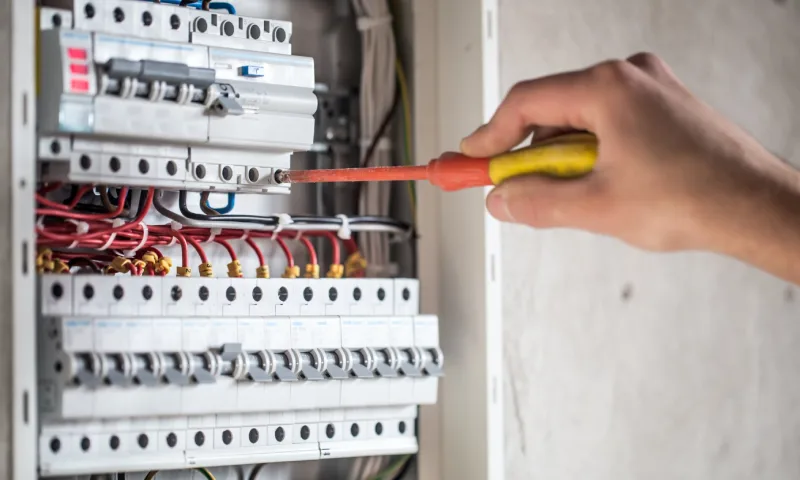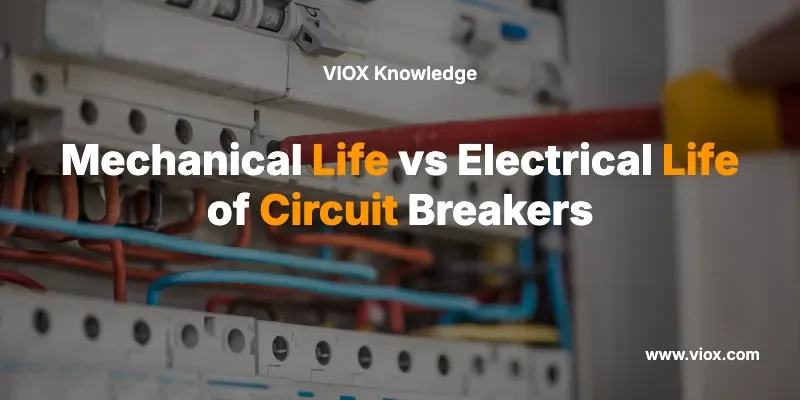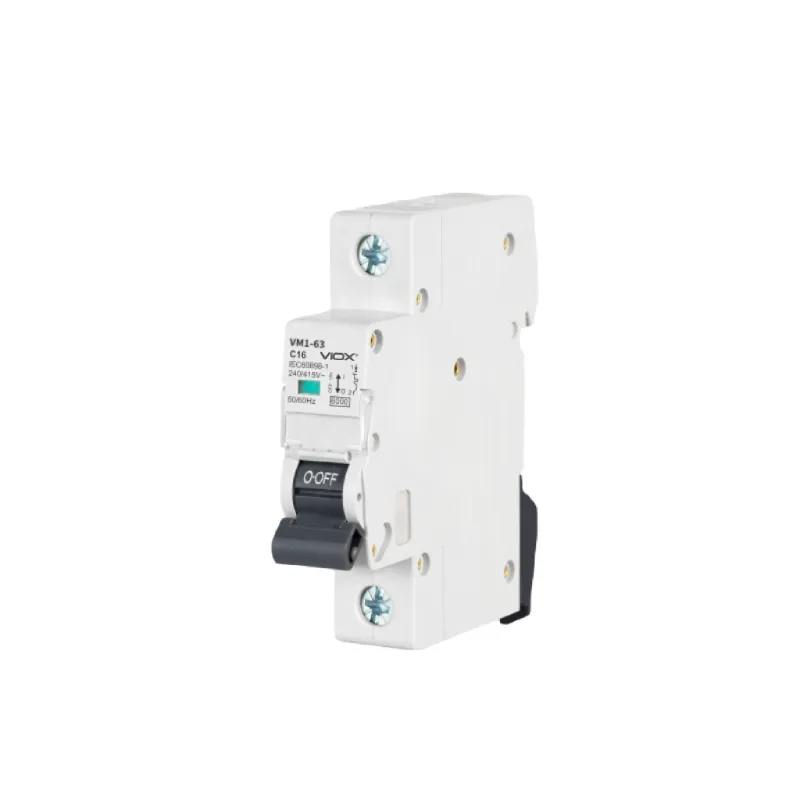Respuesta Directa: La vida mecánica de un interruptor se refiere al número total de operaciones de apertura/cierre que puede realizar sin carga, mientras que la vida eléctrica se refiere al número de operaciones que puede realizar interrumpiendo la corriente eléctrica. La vida mecánica suele ser de 10 a 50 veces mayor que la eléctrica, con operaciones mecánicas de entre 10 000 y 30 000 ciclos, en comparación con las operaciones eléctricas de entre 100 y 3000 ciclos.
Comprender estas diferencias es crucial para una correcta interruptor de circuito selección, programación de mantenimiento y garantía de la seguridad y confiabilidad del sistema eléctrico.

¿Qué son la vida mecánica y la vida eléctrica?
Definición de vida mecánica
La vida mecánica representa el número máximo de operaciones de apertura y cierre que un disyuntor puede realizar cuando sin corriente eléctrica fluye a través de él. Se trata de movimientos puramente mecánicos de los contactos del interruptor, sin tensión eléctrica ni formación de arco.
Definición de vida eléctrica
La vida eléctrica indica el número máximo de operaciones que puede realizar un disyuntor mientras interrumpir la corriente eléctrica En condiciones normales o de falla, cada operación eléctrica somete al interruptor a tensión eléctrica, formación de arcos y erosión de contactos.
Diferencias clave entre la vida mecánica y la vida eléctrica
| Aspecto | Vida mecánica | Vida eléctrica |
|---|---|---|
| Definición | Operaciones sin flujo de corriente | Operaciones mientras se interrumpe la corriente |
| Rango típico | 10.000-30.000 ciclos | 100-3.000 ciclos |
| Factores de estrés | Solo para uso físico | Estrés eléctrico + desgaste físico |
| Formación de arco | Ninguno | Se produce un arco eléctrico significativo |
| Erosión por contacto | Mínimo | Degradación progresiva |
| Norma de ensayo | IEC 62271-100, IEEE C37.09 | IEC 62271-100, IEEE C37.04 |
| Impacto del mantenimiento | Patrones de desgaste predecibles | Requiere pruebas eléctricas |
Comparación del estrés operacional
| Tipo de estrés | Operaciones mecánicas | Operaciones eléctricas |
|---|---|---|
| Desgaste físico | Muelles, varillajes, mecanismos | Todos los componentes mecánicos |
| En Contacto Con La Degradación De Los | Oxidación superficial únicamente | Erosión por arco, picaduras y soldadura |
| Efectos de la temperatura | Sólo temperatura ambiente | Temperaturas del arco (15.000 °C+) |
| Estrés de aislamiento | Ninguno | Riesgo de ruptura dieléctrica |
| Degradación del gas y el petróleo | Mínimo | Descomposición por arco eléctrico |
¿Por qué la vida útil eléctrica es significativamente más corta?
Impacto de la formación del arco: Cuando un disyuntor interrumpe la corriente, se forma un arco eléctrico entre los contactos de apertura. Este arco:
- Alcanza temperaturas superiores a 15.000°C
- Provoca erosión del material de contacto.
- Crea vapor de metal y descomposición de gases.
- Genera fuerzas electromagnéticas
Proceso de erosión por contacto: Cada operación eléctrica elimina cantidades microscópicas de material de contacto a través de:
- Erosión térmica de la temperatura del arco
- Erosión mecánica de fuerzas electromagnéticas
- Erosión química de la oxidación y la contaminación
- Erosión eléctrica de los efectos de densidad de corriente
⚠️ De Advertencia De Seguridad: Nunca opere los disyuntores más allá de su vida útil eléctrica nominal ya que esto puede provocar fallas catastróficas, incendios o peligros de explosión.
Especificaciones de vida útil del disyuntor por tipo
Disyuntores de baja tensión (≤1000 V)
| Tipo de disyuntor | Vida mecánica | Vida eléctrica | Aplicaciones Típicas |
|---|---|---|---|
| Miniatura (MCB) | 20.000 ciclos | 10.000 a corriente nominal | Residencial, comercial ligero |
| Caja moldeada (MCCB) | 10.000-25.000 ciclos | 1.000-10.000 ciclos | Distribución industrial |
| Caja aislada (ICCB) | 10.000 ciclos | 3.000-5.000 ciclos | Control de motores, alimentadores |
| Circuito de aire (ACB) | 10.000-30.000 ciclos | 1.000-8.000 ciclos | Distribución principal |
Interruptores automáticos de media tensión (1 kV-38 kV)
| Tecnología | Vida mecánica | Vida eléctrica | Características principales |
|---|---|---|---|
| Vacío | 10.000-30.000 ciclos | 100-3.000 ciclos | Mantenimiento mínimo |
| Gas SF6 | 10.000-25.000 ciclos | 100-2.000 ciclos | Alta capacidad de interrupción |
| Explosión de aire | 10.000 ciclos | 500-1.500 ciclos | Tecnología heredada |
| Aceite | 5.000-10.000 ciclos | 300-1.000 ciclos | Instalaciones antiguas |
Disyuntores de alta tensión (>38 kV)
| Clase de voltaje | Vida mecánica | Vida eléctrica | Consideraciones críticas |
|---|---|---|---|
| 72,5 kV | 10.000 ciclos | 100-500 ciclos | Aplicaciones de transmisión |
| 145 kV | 10.000 ciclos | 100-300 ciclos | Interconexión de la red |
| 245 kV+ | 5.000-10.000 ciclos | 50-200 ciclos | Infraestructura crítica |
Factores que afectan la vida útil del disyuntor
Factores de vida mecánicos
- Tipo de mecanismo de operación (resorte, hidráulico, neumático)
- Temperatura y humedad ambiente
- Vibración y condiciones sísmicas
- Calidad y frecuencia del mantenimiento
- Estado de lubricación
Factores de vida eléctrica
- Magnitud de la corriente de falla (mayor corriente = vida útil más corta)
- Duración del arco (apertura más rápida = mayor vida útil)
- Factor de potencia (cargas inductivas más severas)
- Voltaje de recuperación (tasa de recuperación del voltaje del sistema)
- Secuencia de operación (cerrar-abrir vs. abrir-cerrar-abrir)
Consejo De Expertos: Los disyuntores utilizados en aplicaciones de arranque de motores experimentan una vida útil eléctrica reducida debido a las altas corrientes de entrada, incluso si técnicamente no son condiciones de falla.
Cómo determinar los requisitos de vida útil del disyuntor
Paso 1: Analizar las condiciones de funcionamiento
- Calcular lo esperado operaciones mecánicas por año
- Estimar operaciones eléctricas por año
- Identificar niveles máximos de corriente de falla
- Determinar requisitos del ciclo de trabajo
Paso 2: Aplicar factores de reducción
| Condición | Factor de reducción | Aplicación |
|---|---|---|
| Corriente de falla alta | 0.5-0.8 | Reducir la vida útil eléctrica |
| Cambio frecuente | 0.7-0.9 | Reducir la vida mecánica |
| Mal mantenimiento | 0.6-0.8 | Aplicar a ambos |
| Ambiente áspero | 0.8-0.9 | Principalmente mecánico |
| Aplicación crítica | 0.5-0.7 | Factor de seguridad conservador |
Paso 3: Calcular la vida útil requerida
Vida mecánica requerida = (operaciones mecánicas anuales × años de servicio) ÷ factor de reducción Vida eléctrica requerida = (operaciones eléctricas anuales × años de servicio) ÷ factor de reducción
Estrategias de mantenimiento y prolongación de la vida útil
Extensión de la vida mecánica
- Lubricación regular de mecanismos de funcionamiento
- Calibración de configuraciones y tiempos de viaje
- Inspección de resortes y varillajes
- De protección ambiental (calefacción, ventilación)
- Monitoreo de vibraciones en aplicaciones críticas
Extensión de la vida eléctrica
- Monitoreo de la resistencia de contacto para detectar la erosión
- Prueba de aislamiento para verificar la integridad dieléctrica
- Inspección de la cámara de arco por contaminación
- Reemplazo de contactos a 70-80% de vida nominal
- Análisis de gas/petróleo para productos de descomposición
⚠️ Recomendación Profesional: Las pruebas eléctricas deben ser realizadas por técnicos calificados utilizando procedimientos de seguridad y EPP adecuados.
Normas y requisitos de prueba
Las Normas Internacionales
- IEC 62271-100: Aparatos de conmutación y control de alta tensión
- IEC 60947-2: Aparatos de conmutación y control de baja tensión
- IEEE C37.04: Estructura de clasificación para interruptores automáticos de alto voltaje de CA
- IEEE C37.09: Procedimientos de prueba para interruptores automáticos de alto voltaje de CA
Categorías de prueba
- Prueba de tipo – Verificación del diseño por parte del fabricante
- Pruebas de rutina – Cada unidad fabricada
- Pruebas periódicas – Verificación en servicio
- Evaluación de la condición – Evaluación de vida restante
Criterios de selección para la vida útil del interruptor
Cuando la vida mecánica es la preocupación principal
- Aplicaciones de conmutación de carga (transformadores, condensadores)
- Sistemas de conmutación de transferencia
- Operaciones de conmutación de mantenimiento
- Aplicaciones de control remoto
Cuando la vida útil eléctrica es la principal preocupación
- Falla aplicaciones de protección
- Arranque/parada del motor
- Protección del horno de arco
- Conmutación del banco de condensadores
Matriz de decisión para requisitos de vida
| Tipo De Aplicación | Factor de prioridad | Relación de vida típica (M:E) |
|---|---|---|
| Sólo protección | Vida eléctrica | 20:1 a 50:1 |
| Conmutación de carga | Vida mecánica | 10:1 a 20:1 |
| De control del Motor | Ambos son iguales | 5:1 a 15:1 |
| Conmutación de condensadores | Vida eléctrica | 15:1 a 30:1 |
Preguntas Frecuentes
¿Qué sucede cuando un disyuntor excede su vida útil eléctrica?
Cuando se excede la vida eléctrica, la erosión de los contactos aumenta el riesgo de falla, la capacidad de interrupción del arco disminuye y el interruptor puede no eliminar las fallas de manera segura, lo que puede causar daños al equipo o riesgos de incendio.
¿Puede la vida mecánica convertirse en vida eléctrica?
No, estas son clasificaciones independientes. Operar un interruptor eléctrico siempre consume tanto la vida mecánica como la eléctrica, pero las operaciones mecánicas solo consumen la vida mecánica.
¿Cómo se supervisa la vida útil del disyuntor en servicio?
Utilice contadores de operaciones para operaciones mecánicas, monitoreo de corriente de falla para estrés eléctrico, mediciones de resistencia de contacto y pruebas de mantenimiento periódicas según las recomendaciones del fabricante.
¿Cuál es la diferencia entre la vida nominal y la vida real?
La vida útil nominal se basa en las condiciones de prueba de laboratorio. La vida útil real depende del entorno operativo, los niveles de corriente, la calidad del mantenimiento y las tensiones específicas de la aplicación.
¿Debo reemplazar los disyuntores cuando tienen una vida útil nominal de 100%?
Las mejores prácticas de la industria recomiendan el reemplazo o la renovación importante entre 70 y 80% de vida útil eléctrica nominal para mantener una protección confiable y márgenes de seguridad.
¿Cómo afecta el nivel de corriente de falla a la vida eléctrica?
Corrientes de falla más altas generan arcos eléctricos más severos, lo que reduce exponencialmente la vida útil. Un interruptor que interrumpe 50% de corriente nominal puede alcanzar una vida útil de 2 a 3 veces mayor.
¿Es posible prolongar la vida útil del disyuntor mediante mantenimiento?
La vida útil mecánica puede prolongarse significativamente mediante un mantenimiento adecuado. La vida útil eléctrica puede restaurarse parcialmente mediante el reemplazo de contactos, pero la cámara de interrupción tiene una vida útil limitada.
¿Qué documentación se requiere para el seguimiento de vida?
Mantenga registros de operaciones, registros de corrientes de falla, historiales de mantenimiento, resultados de pruebas y curvas de vida útil del fabricante para una evaluación precisa de la vida útil y el cumplimiento normativo.
Directrices de selección de expertos
Para nuevas instalaciones:
- Calcular las operaciones esperadas durante la vida útil del diseño
- Aplicar factores de seguridad adecuados (normalmente entre 1,5 y 2,0)
- Considere el crecimiento futuro del sistema y los niveles de fallas
- Especificar capacidades de monitoreo para el seguimiento de la vida
Para sistemas existentes:
- Revisar datos históricos de operaciones
- Evaluar la condición actual mediante pruebas
- Planifique el reemplazo antes de alcanzar los límites críticos de vida útil
- Considere actualizar a tecnologías de mayor duración
⚠️ Nota de seguridad crítica: La vida útil nominal de los interruptores es un parámetro fundamental de seguridad. Superar la vida útil nominal puede provocar que no se interrumpan las corrientes de falla, lo que puede causar daños catastróficos al equipo, incendios o lesiones personales. Consulte siempre con ingenieros eléctricos cualificados para aplicaciones críticas y mantenga registros detallados de funcionamiento para el seguimiento de su vida útil.
Relacionados con la
IEC 60898-1 vs IEC 60947-2: Guía completa sobre las normas de interruptores eléctricos
GFCI vs AFCI: La guía completa sobre interruptores de seguridad eléctrica






